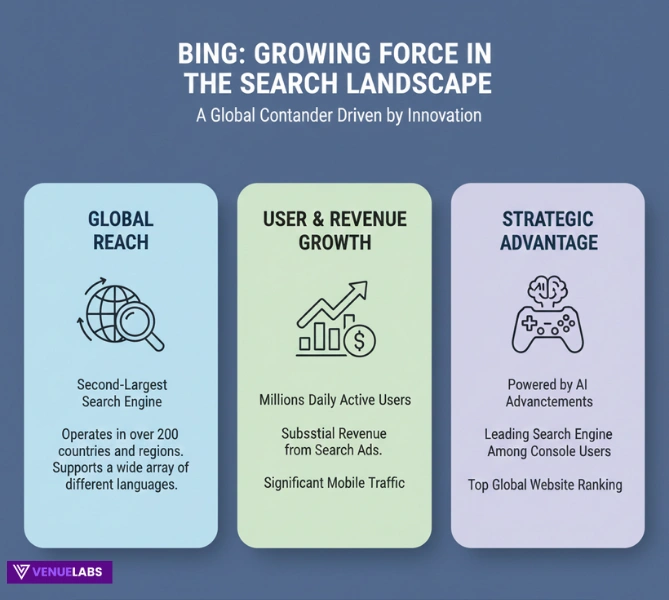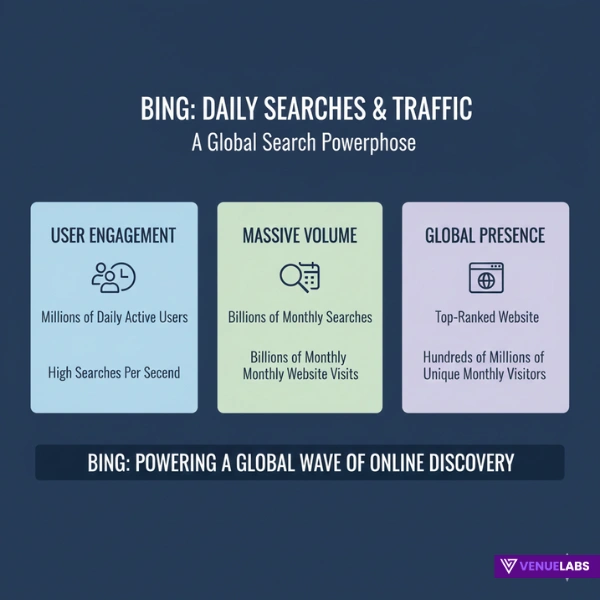Microsoft Bing stands as the second-largest search engine in the world after Google.
Users turn to Bing for quick searches, AI-powered insights, and integrated tools that enhance productivity.
In 2025, Bing continues to grow its presence through innovations like Copilot AI, attracting over 100 million daily active users. This article explores key Bing statistics 2025, including market share, user demographics, revenue figures, and emerging trends.
Readers who want to learn more about Bing will discover practical ways to use it for personal searches, business advertising, and daily efficiency.
Bing offers unique benefits like lower ad costs, visual search features, and rewards programs that help users save time and money.
Bing launched in 2009 as Microsoft’s answer to Google’s dominance. It powers searches on Windows devices, Xbox consoles, and mobile apps.
By integrating AI through Copilot, Bing delivers conversational answers, summaries, and creative tools that go beyond traditional results. Businesses benefit from Bing Ads, which often show higher click-through rates at lower costs compared to Google Ads.
Individuals use Bing for image and video searches, earning rewards for everyday queries. As Google faces antitrust scrutiny, Bing gains traction with privacy-focused users and those seeking alternatives.
Let’s dive into the detailed Bing statistics 2025 to see how this engine works and how you can leverage it.
Bing Market Share in 2025

Bing holds a solid position in the global search engine market. As of early 2025, Bing commands about 3.95% of the worldwide market share, while Google dominates with 90.14%.
This marks a slight increase from previous years, thanks to AI integrations and partnerships. On desktop devices, Bing performs better, capturing 12.21% globally.
In the United States, Bing’s all-device market share reaches 7.5%, one of its highest levels ever. This growth reflects users switching for better AI features and less cluttered results.
Bing excels in specific niches. It leads on U.S. game consoles with 38.46% market share, making it the default choice for Xbox users.
Globally, Bing’s desktop share in the U.S. hovers around 14.5%. Mobile traffic accounts for 71% of Bing’s visits, showing strong smartphone adoption.
Businesses targeting desktop users or gamers find Bing valuable for reaching high-income audiences.
Table: Bing Market Share Breakdown (2025)
| Category | Market Share (%) | Notes |
| Global All Devices | 3.95 | Second to Google |
| Global Desktop | 12.21 | Strong performance on PCs |
| U.S. All Devices | 7.5 | Highest recorded |
| U.S. Consoles | 38.46 | Xbox default engine |
| Mobile Traffic (Bing) | 71 | Dominant on smartphones |
These figures highlight Bing’s niche strengths. Advertisers benefit by bidding on less competitive keywords, often at lower costs per click (CPC) of about $1.54.
For users, this means faster, more relevant results in specialized areas like gaming or enterprise searches.
Also read about: Google Searches Statistics
Bing Usage and Traffic Statistics

Bing processes massive volumes of searches daily. It handles over 100 million daily active users, with surges from Copilot AI adoption. In March 2025, Bing.com welcomed 5.28 billion visitors monthly.
This equates to 2.7 billion searches per month or about 10,417 per second. Users appreciate Bing’s visual previews for videos and images, which enhance browsing.
Top searches on Bing often link to major sites. Facebook tops the list with millions of queries, followed by YouTube and even Google itself. This shows Bing serves as a gateway to other platforms.
In 2025, AI features like Copilot drive higher engagement, with 33 million active users across apps and web. Businesses use this data to optimize ads, targeting branded searches that convert at 2.94% rates.
Bing’s traffic comes from diverse sources. It ranks #6 globally among websites. Over 85% of U.S. users rely on Bing, with strong presence on Windows devices. For everyday users, Bing’s rewards program incentivizes searches, offering points for gift cards or donations.
Table: Top Bing Searches (Monthly Estimates):
| Rank | Query | Searches |
| 1 | 12.98M | |
| 2 | YouTube | 11.45M |
| 3 | 8.06M | |
| 4 | Gmail | 6.04M |
| 5 | Amazon | 4.84M |
These patterns reveal opportunities. Marketers target high-intent queries like shopping or news, benefiting from Bing’s 45% higher CTR for shopping ads.
Also read about: Google Ads Statistics
Bing User Demographics and Who Uses It

Bing attracts a valuable audience. In the U.S., 74% of users fall under 45, with 25-34 year-olds leading at the most popular group.
Females make up 50% of users, balancing the gender split. Higher-income households dominate, with 38% earning over $100,000 annually and 48% in the top 25%. College graduates represent 34%.
Business executives prefer Bing at 23%. Over 70% of users are 35+, appealing to mature demographics. Married users account for 43%. This group spends 32% more online, making them ideal for e-commerce ads.
Geographically, the U.S. leads with 27.99% of traffic, followed by China at 7.45%. Bing serves 238 countries and 105 languages. Users benefit by accessing localized results and tools like Bing Translator.
Table: Bing User Demographics (U.S. Focus)
| Demographic | Percentage | Benefit for Users |
| Age 25-34 | Highest | Tech-savvy searches |
| Female Users | 50 | Balanced audience |
| Income >$100K | 38 | High spending power |
| College Graduates | 34 | Educated queries |
| Married | 43 | Family-oriented ads |
These stats guide personalization. Users in high-income brackets enjoy tailored shopping results, while businesses target executives for B2B leads.
Also read about: Google Chrome Statistics
Bing Revenue and Advertising Insights
Bing generates significant revenue from ads. In FY2023, Microsoft earned $12.21 billion from search ads. Projections for 2024 hit $12.58 billion. Average revenue per user (ARPU) stands at $9.66. Ads perform well, with 2.83% CTR, $1.54 CPC, and $41.44 cost per action.
Bing Ads offer advantages over Google. Shopping ads see 45% higher CTR. In 2025, e-commerce firms shift budgets to Bing for AI-driven targeting and lower competition. Advertisers benefit from 69% branded searches.
Valuation estimates place Bing at $400 billion in 2023, growing steadily. Users indirectly benefit through free tools funded by ads.
Table: Bing Ad Revenue (Recent Years)
| Year | Revenue ($B) |
| 2023 | 12.21 |
| 2022 | 11.59 |
| 2021 | 8.53 |
Bing’s AI Revolution with Copilot
Copilot transforms Bing in 2025. It boasts 33 million active users and 89 million monthly visits in April. Over 60% of Fortune 500 companies adopt it, boosting productivity by 77%. Bing Chat accuracy reaches 81.8%.
Users ask Copilot for summaries, code, and creative content. Integration with Microsoft 365 enhances workflows. Businesses save time on research, while individuals generate images or plan tasks.
Latest Trends from Quora and Reddit
On Reddit, users discuss Bing’s growth to 11-12% desktop share in the U.S., crediting Copilot for surges in daily active users by 40 million. Threads highlight Bing’s cleaner results versus Google’s clutter. E-commerce shifts to Bing Ads in 2025 for better ROI.
Quora users query demographics, noting Bing’s appeal to females and high earners. Questions focus on why people choose Bing for privacy and visuals. Trends show interest in AI accuracy and ad performance.
How to Use Bing for Your Benefit
Set Bing as default on Windows or Edge for seamless integration. Earn rewards by searching—redeem for gift cards. Use Copilot for quick answers, saving hours on research. Businesses run Bing Ads for targeted campaigns, enjoying lower CPC and higher conversions.
Visual searches help shoppers preview products. For privacy, Bing limits tracking compared to rivals. Integrate with Office for AI-assisted writing.
Risks and Considerations
Bing faces volatility from AI competition. Users note occasional inaccuracies, but updates improve reliability. Advertisers watch for click fraud, though metrics remain strong.
FAQs About Bing Statistics
1. What is Bing's global market share in 2025?
Bing holds about 3.95% of the global search market in 2025, positioning it as the second-largest engine after Google.
2. How many daily users does Bing have?
Bing surpasses 100 million daily active users in 2025, boosted by Copilot AI features.
3. Who are typical Bing users?
Bing users often include high-income individuals over 35, with balanced gender representation and strong U.S. presence.
4. How does Bing make money?
Bing earns revenue primarily through search ads via Microsoft Advertising, generating billions annually with strong performance metrics.
5. Why choose Bing over Google?
Users select Bing for AI tools like Copilot, visual results, rewards, and lower ad competition, offering unique benefits in productivity and privacy.
Also Read:
- Artificial Intelligence Statistics
- Gemini Statistics
- Metaverse Statistics
- Google Ads Statistics
- Content Marketing Statistics
Conclusion
Bing’s statistics for 2025 highlight its impressive growth and increased relevance, particularly with the integration of AI tools like Copilot.
Despite Google’s dominance, Bing continues to carve out its niche, offering a cost-effective alternative for advertisers, enhanced search features for users, and a growing user base that appreciates privacy, visual search, and efficiency.
As its market share rises, businesses and individuals alike can leverage Bing’s strengths—whether through lower ad costs, improved user engagement, or AI-driven productivity tools.
With steady growth and a clear focus on innovation, Bing remains a key player in the search engine landscape in 2025 and beyond.
Source: StatCounter, Statista
